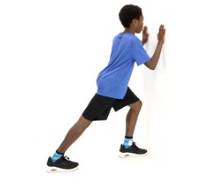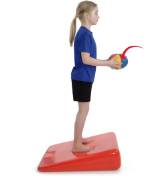Toddlers
In this section you will find information relating to conditions affecting toddlers. Click onto each title to read more details.
► Tip toe walkers
Under three’s
Children under the age of three will often walk on their tip toes. Sometimes there can be a family history of walking on tip toes. In most cases, there is nothing to worry about and this can be considered a ‘normal variant’; something that is commonly seen in typically developing children. Usually, toe walking will resolve.
If walking on the toes persists, the calf muscles can become tight and then it can be even harder for children to get their heels down. This is why it is helpful to discourage it.
If your child is able to stand with the heels down, there are things you can do to help prevent toe walking:
- Try to encourage activities that keep the heels down such as making footprints in sand or footprint painting. Try drawing around your child’s feet!
- Try walking along a line as if on a tightrope
- Standing on one leg
- Ask the child if they can walk on their heels like a penguin (keeping the toes off the floor)
- Get some stiff/sturdy boots for the child to wear. This should help to decrease the toe walking. Have the child wear the boots, indoors and outdoors, to try to break the habit.
- Calf stretches – try some simple calf stretches as shown in the pictures below. Ensure that the toes/feet are facing forward for these stretches.
 |
 |
If your child is unable to stand with their heels down, they will need to be seen for an assessment.
► in-toeing gait or ‘pigeon toes’
Walking with the feet turned in is common in children under eight. It can result in more frequent falls as children can trip over their own feet. In most children the in-toeing resolves, without treatment, before the age of 10.
Causes
In-toeing can be caused by several factors:
- Femoral anteversion – the thigh bone rotates inwards (the whole leg turns in)
- Tibial torsion – the tibia bone rotates in (the knee is straight but the leg looks turned in at the ankle)
- Metatarsus abductus – the foot bends inwards (the outside boarder of the foot will be curved).
If your child is in-toeing, try some of the following suggestions:
- Sitting with legs crossed or with the soles of the feet together (butterfly sitting) and avoid ‘W’ sitting
- Wear good fitting, supportive footwear
- Try activities that encourage external rotation such as ballet, horse-riding or swimming breaststroke.
► Out-toeing gait (walking with the feet turned out)
Walking with the feet turned out is very common in children. This usually resolves by the age of four. You should be seen by a health professional if there is a sudden change in the way that your child walks. Also seek advice if only one leg turns out.
► Flat feet
Most adults will have an arch that runs along the inside of the foot. People who don’t have this, where the inside boarder of the foot is in contact with the floor, are said to have flat-feet. This is also called pes planus.
Flat feet are very common in children under the age of six. There are several reasons for this:
- Children have more fatty tissue in their feet, making it harder to see an arch
- There are lots of ligaments in the feet which are more flexible in children, so the foot shape flattens out more when the child is weight-bearing through the feet
- The arch develops over time. All children under the age of three will have flat feet as the arch has not developed. After the age of six, an arch may be more visible.
Generally, unless your child complains of pain, they will not need to be seen or treated by a health professional if they are under the age of six. Often, if the child stands on tip toes, or if the big toe is raised in standing, an arch forms.
Older children who have flat feet may need to be seen by a health professional, particularly if there is pain or stiffness in the feet.
If your child’s feet look different, for example if one side has an arch and the other doesn’t, this should be checked by a health professional. Also, if the arch is so flat that the back of the heel does not look straight, then this may need to be checked by a health professional.
Treatment
Sometimes flat feet can cause pain, or lead to other problems such as knee or hip pain. Treatment may include orthotic insoles, to support the arches of the feet, or exercises. Rarely, in older children, the bones in the foot can become fused and surgery is required.
► Knock knees
Knock knees or genu valgum is common in young children. This usually resolves, without treatment, by the age of six.
Between the ages of two and four it is normal for there to be a gap between the ankles of 6-7 cm (when the knees are together). The legs usually appear straighter as the child gets older.
► Bow legs
Bow legs (or physiologic genu varum) is when the legs bow leaving a gap between the knees when the ankles are together.
This is thought to be normal in typically developing children up until the age of two, where the legs will then start to straighten out. Children may even become slightly knock-kneed before they straighten out fully. This is also considered to be part of normal development and is nothing to worry about.
There are some cases of bow legs that require further investigation. Please see a specialist (such as a paediatric physiotherapist or paediatric orthopaedic consultant) if your child has any of the following:
- Leg pain
- Asymmetry of the legs where one leg is bowed and the other is straight, or if one leg is more bowed compared to the other
- Bowing of the legs after the age of two, and you don’t feel that it is correcting naturally
- The distance between the knees when the ankles are together is more than 6 cm.
Last Modified: 11:43am 22/01/2024
